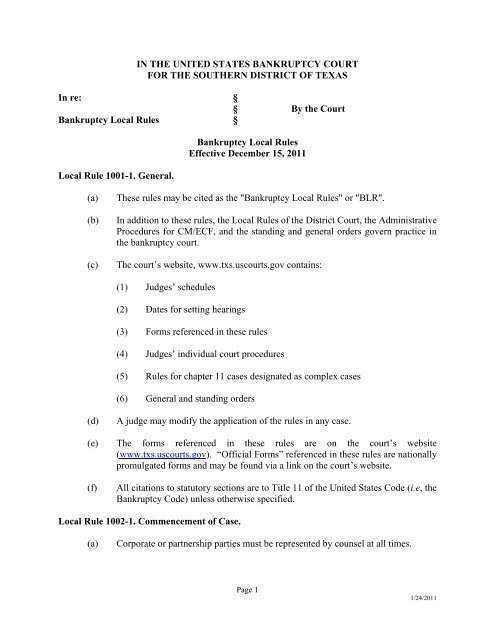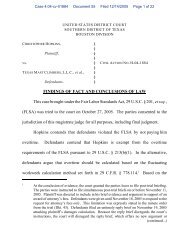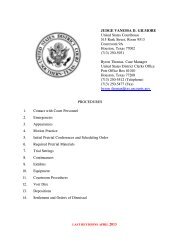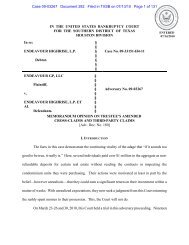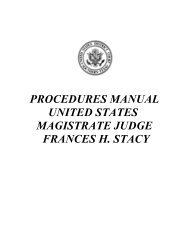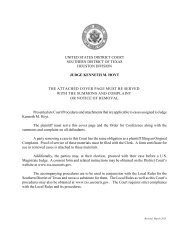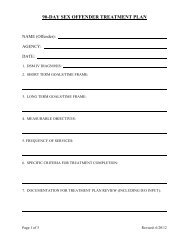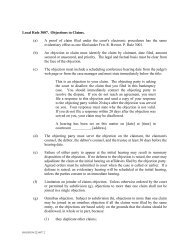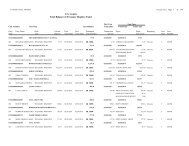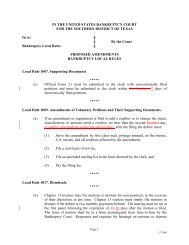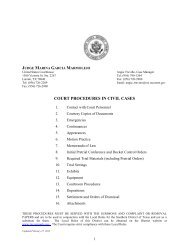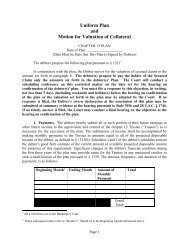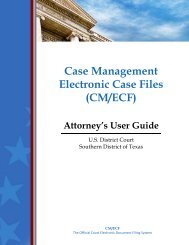Local Rules - Southern District of Texas
Local Rules - Southern District of Texas
Local Rules - Southern District of Texas
Create successful ePaper yourself
Turn your PDF publications into a flip-book with our unique Google optimized e-Paper software.
IN THE UNITED STATES BANKRUPTCY COURTFOR THE SOUTHERN DISTRICT OF TEXASIn re: §§ By the CourtBankruptcy <strong>Local</strong> <strong>Rules</strong> §<strong>Local</strong> Rule 1001-1. General.Bankruptcy <strong>Local</strong> <strong>Rules</strong>Effective December 15, 2011(a)(b)(c)These rules may be cited as the "Bankruptcy <strong>Local</strong> <strong>Rules</strong>" or "BLR".In addition to these rules, the <strong>Local</strong> <strong>Rules</strong> <strong>of</strong> the <strong>District</strong> Court, the AdministrativeProcedures for CM/ECF, and the standing and general orders govern practice inthe bankruptcy court.The court’s website, www.txs.uscourts.gov contains:(1) Judges’ schedules(2) Dates for setting hearings(3) Forms referenced in these rules(4) Judges’ individual court procedures(5) <strong>Rules</strong> for chapter 11 cases designated as complex cases(6) General and standing orders(d)A judge may modify the application <strong>of</strong> the rules in any case.(e) The forms referenced in these rules are on the court’s website(www.txs.uscourts.gov). “Official Forms” referenced in these rules are nationallypromulgated forms and may be found via a link on the court’s website.(f)All citations to statutory sections are to Title 11 <strong>of</strong> the United States Code (i.e, theBankruptcy Code) unless otherwise specified.<strong>Local</strong> Rule 1002-1. Commencement <strong>of</strong> Case.(a)Corporate or partnership parties must be represented by counsel at all times.Page 11/24/2011
(b)(c)(d)Cases should be filed in the division <strong>of</strong> the debtor’s “principal location”, asdefined in subparagraphs (c) and (d). Absent good cause, cases filed outside <strong>of</strong>the debtor’s principal location will be transferred by the court sua sponte or onmotion <strong>of</strong> a party.For an individual debtor, the debtor's principal location is the county <strong>of</strong> thedebtor's principal residence or domicile for the longest portion <strong>of</strong> the 180 dayspreceding the date <strong>of</strong> the petition. If an individual debtor did not have a principalresidence or domicile within the <strong>Southern</strong> <strong>District</strong> <strong>of</strong> <strong>Texas</strong> for at least 91 daysbefore the filing <strong>of</strong> the petition, the individual debtor's principal location is thecounty <strong>of</strong> the debtor's principal assets within the <strong>Southern</strong> <strong>District</strong> <strong>of</strong> <strong>Texas</strong>.For a debtor that is not an individual, the debtor's principal location is the county<strong>of</strong> the debtor's principal executive <strong>of</strong>fices or principal assets, if either has beenlocated within the <strong>Southern</strong> <strong>District</strong> <strong>of</strong> <strong>Texas</strong> for at least 91 days prior to the filing<strong>of</strong> the petition.<strong>Local</strong> Rule 1007-1. Supporting Documents.(a)(b)(c)(d)On schedules D, E, and F <strong>of</strong> Official Form 6, creditors must be in alphabeticalorder.In individual or joint cases, Schedules B and C <strong>of</strong> Official Form 6 must contain adetailed inventory <strong>of</strong> the debtor’s personal property, with each item valuedseparately.Official Form 21 must be submitted to the clerk with conventionally filedpetitions and must be submitted to the clerk within 7 days <strong>of</strong> electronically filedpetitions.In all Chapter 13 Cases, the debtor must file with the plan:(1) If the debtor is a wage or salary employee, the debtor must file a wageorder with service on the Trustee; or(2) If the debtor is not a wage or salary employee, the debtor must file(A)(B)a proposed Order For EFT Payments (Online Banking) andDebtor’s Certification; ora proposed Order For ACH Payments and Debtor’s Certification,each on the form promulgated from time to time by the Court.Page 21/24/2011
(3) If the debtor feels there are extraordinary circumstances justifying anexception to (1) or (2) above, file a motion to allow direct payment <strong>of</strong>funds to the Trustee.<strong>Local</strong> Rule 1009-1. Amendments <strong>of</strong> Voluntary Petitions and Their Supporting Documents.(a)If an amendment or supplement is filed to add a creditor or to change the status,classification, or amount owed a creditor, no later than the second day, excludingintermediate weekends and holidays, after the filing the debtor must:(1) Serve the amendment by first class mail, postage prepaid, on the trustee,U.S. trustee, and all creditors affected by the amendment,(2) File a certificate <strong>of</strong> service,(3) File an amended mailing list in the form directed by the clerk, and(4) Pay the filing fee.(b)(c)(d)Amendments to schedules must be marked to identify added, deleted or changedinformation.If it appears to the court or trustee that the supporting documents need to beamended, the court or trustee may notify the debtor, specifying the items,documents, and time for amendment.If the debtor moves to correct an erroneous social security number, the debtormust serve all parties in interest. The proposed form <strong>of</strong> order must extend thedeadline for objecting to exemptions and discharge if necessary.<strong>Local</strong> Rule 1014-1. Intradistrict Transfer.On motion <strong>of</strong> a party in interest or on its own motion, the judge may transfer a case, an adversaryproceeding, or a contested proceeding to another judge or division in this district. This rule doesnot apply to the reassignment <strong>of</strong> a judge following a recusal.<strong>Local</strong> Rule 1015-1. Joint Administration.(a)Motions and proposed orders for joint administration should itemize the requestedrelief. The motion and order must be in the form published on the court’swebsite.Page 31/24/2011
(b)A motion for joint administration must be made to the judge with the lowest casenumber.<strong>Local</strong> Rule 1017-2. Dismissals.(a)Among the reasons a case may be dismissed for want <strong>of</strong> prosecution under FED.R. BANKR. P. 1017 are:(1) Incomplete or late schedules filed by the debtor;(2) The failure <strong>of</strong> a non-individual debtor to act through counsel in the filing<strong>of</strong> a bankruptcy petition or the prosecution <strong>of</strong> a case;(3) Unpaid or late filing fees by the debtor;(4) Failure by the debtor to timely file mailing lists <strong>of</strong> creditors in theprescribed format;(5) Failure by the debtor to include the required creditors list with the petition;(6) Failure by the debtor to timely file the forms required by BLR 1007-1;(7) The debtor’s lack <strong>of</strong> diligent, prompt prosecution through filing <strong>of</strong> a planlate, missing or incomplete disclosure statement or other documentrequired by the code, rules, or orders;(8) The debtor’s failure to attend the § 341 creditors meeting;(9) The debtor’s failure to timely amend schedules requested by the trustee orthe U. S. trustee; and(10) Unpaid U.S. trustee quarterly fees.(b)Chapter 13 trustees may file motions to dismiss for non-payment, in the exercise<strong>of</strong> their discretion, at any time. Chapter 13 trustees must timely file motions todismiss if the debtor is two monthly payments behind. The hearing must be set atthe first panel following the expiration <strong>of</strong> 28 days after the motion is filed. Theform <strong>of</strong> motion shall be in a form promulgated from time-to-time by theBankruptcy Court. Responses and requests for hearings on motions to dismissmust be filed not later than 21 days after service. If no timely response is filed,the Court may dismiss the case without a hearing, at its discretion.Page 41/24/2011
(c)In chapter 13 cases, federal tax issues will be governed by the followingprocedures:(1) At or before 7 days before the date first set for the first § 341 meeting <strong>of</strong>creditors, the Internal Revenue Service must send a tax transcript to thechapter 13 trustee, the debtor and debtor’s counsel.(2) Within 7 days after the § 341 meeting <strong>of</strong> creditors, the trustee must file amotion to dismiss any chapter 13 case in which the IRS transcript reflectsa delinquent return for a period in which taxes would be entitled to apriority. The motion shall be in a form published from time-to-time on theCourt’s website.(3) Within 21 days after the chapter 13 trustee has filed a motion to dismiss acase based on delinquent tax returns, the debtor must file a response to themotion.(4) If all tax returns that are the subject <strong>of</strong> a motion under BLR 1017-2(b)have not been filed, the plan will not be confirmed. If all tax returns havebeen filed, the court may confirm the plan or may deny confirmationbased on an estimate <strong>of</strong> the IRS’s claim pursuant to § 502(c). The orderconfirming the plan will provide that the plan has been confirmed basedon an estimate <strong>of</strong> the debtor’s tax liability and that the actual amountpayable by the debtor in order to discharge the tax liability will be theactual amount determined based on the allowance <strong>of</strong> the tax claim, withoutregard for any provision in the plan to the contrary.(5) The proposed order dismissing for failure to file tax returns will providefor dismissal with prejudice until all delinquent returns have been filedand must be in the form published from time-to-time on the Court’swebsite.<strong>Local</strong> Rule 1019-1. Supplemental Schedules in Converted Cases.Within 14 days after entry <strong>of</strong> an order converting a case from one chapter to another, the debtormust file: (1) supplemental schedules itemizing changes from the original schedules in property<strong>of</strong> the estate and in creditor lists, or (2) a statement that there are no changes.Page 51/24/2011
<strong>Local</strong> Rule 1075-1. Complex Cases.Procedures for the administration <strong>of</strong> complex cases are governed by the Procedures for ComplexCases as posted on the Court’s website. Those procedures govern the extent to which the <strong>Texas</strong>Procedures for complex Chapter 11 Cases (also posted on the Court’s website) apply.<strong>Local</strong> Rule 2002-1. Notices to Creditors, Equity Security Holders, and United States.Notices given under Bankruptcy Rule 2002 must be given as ordered by the court. If the courtdoes not enter a separate order directing the method <strong>of</strong> notice, this governs:(a)Under Bankruptcy Rule 2002(a), the court directs that notices that are governedby that rule must be given:(1) With respect to the matters in Bankruptcy Rule 2002(a)(1), notice will begiven by the clerk.(2) With respect to the matters in Bankruptcy Rule 2002(a)(2), notice must begiven by the proponent <strong>of</strong> the proposed use, sale, or lease <strong>of</strong> property.(3) With respect to the matters Bankruptcy Rule 2002(a)(3), notice must begiven:(A)(B)(C)In a chapter 7 case with a compromise involving exempt property,by the debtor; in all other chapter 7 matters, by the trustee.In a chapter 11 case with a debtor in possession, by the debtor inpossession; in a chapter 11 case with a trustee, by the trustee.In a chapter 13 case when the proponent <strong>of</strong> the compromise is thechapter 13 trustee, by the chapter 13 trustee; in all other chapter 13matters, by the debtor.(4) With respect to the matters in Bankruptcy Rule 2002(a)(4), notice must begiven by the proponent <strong>of</strong> the dismissal or conversion.(5) With respect to the matters in Bankruptcy Rule 2002(a)(5), notice must begiven by the proponent <strong>of</strong> the proposed plan modification.(6) With respect to the matters in Bankruptcy Rule 2002(a)(6), notice must begiven by the applicant.Page 61/24/2011
(7) With respect to the matters in Bankruptcy Rule 2002(a)(7), notice must begiven by the clerk if the notice is sent with the notice <strong>of</strong> the initial § 341meeting <strong>of</strong> creditors. All other notices for matters in Bankruptcy Rule2002(a)(7) must be given by the proponent <strong>of</strong> the setting <strong>of</strong> a date for thefiling <strong>of</strong> pro<strong>of</strong>s <strong>of</strong> claim.(8) With respect to the matters set forth in Bankruptcy Rule 2002(a)(8), noticemust be given by the proponent <strong>of</strong> the proposed plan.(b)(c)With respect to the matters in Bankruptcy Rule 2002(b), notices must be given bythe proponent <strong>of</strong> a proposed plan under chapters 9 and 11. With respect to achapter 13 plan, notice must be given by the clerk as set forth in BLR 2002-1(c).The clerk must send a notice promptly after a chapter 13 case is filed. The noticemust:(1) Set the initial meeting <strong>of</strong> creditors under § 341 (the “§ 341 Meeting”) on thefirst available date (available dates are dates on which the chapter 13trustee is conducting meetings) that is not less than 35 days after thepetition date.(2) Set the initial confirmation date for the debtor’s proposed plan. The initialconfirmation date will be set at the last available date (available dates aredates on which the court has scheduled chapter 13 confirmation hearings)that is not more than 45 days after the § 341 meeting. If the plan is filedon the petition date, the notice shall include a copy <strong>of</strong> the plan or the “PlanSummary and Statistical Cover Sheet” (the “plan summary”). If the planis not filed on the petition date, the debtor will be responsible for mailing anew notice along with the plan and the plan summary on the same day thatthe debtor’s proposed plan is filed. In order to maintain earlyconfirmation, judges may have to schedule not less than two confirmationpanels per month. The notice shall advise creditors that the deadline forfiling objections to confirmation <strong>of</strong> the plan is 7 days before the date setfor confirmation. Failure to send the notice with the plan and the plansummary in a timely manner may be grounds for dismissal <strong>of</strong> the case atthe confirmation hearing.(3) Set a hearing on § 506 valuations. The hearing on § 506 valuations willoccur at the hearing on confirmation.Page 71/24/2011
<strong>Local</strong> Rule 2003-1. Section 341 Meetings <strong>of</strong> Creditors or Equity Security Holders.(a)(b)(c)The debtor must attend creditors’ meetings unless excused by the court fromattendance.With trustee’s consent, a debtor may participate at the creditors meeting bytelephone in accordance with procedures established by the U.S. trustee. Anyother requested participation requires a court order. The U.S. trustee’s proceduresare available on the Court’s website.The chapter 13 trustee will file a recommendation regarding confirmation <strong>of</strong> thedebtor’s proposed plan at the conclusion <strong>of</strong> the debtor’s § 341 meeting. If notimely confirmation objection is filed and the trustee recommends confirmation,then the judge may confirm the plan without a hearing or conduct a hearing onconfirmation <strong>of</strong> the plan. The trustee may withdraw a recommendation in favor<strong>of</strong> confirmation at any time. If the trustee withdraws the confirmationrecommendation less than 7 days before confirmation, the confirmation hearingwill be rescheduled.<strong>Local</strong> Rule 2004-1. Examination.(a) The purpose <strong>of</strong> this rule is to avoid a motion and court order for a 2004examination unless an objection is filed and to encourage agreements on anexamination schedule.(b)(c)(d)(e)A written agreement between the proponent, opposing counsel, and the person orentity to be examined <strong>of</strong> date, time, and place <strong>of</strong> a 2004 examination isenforceable by a motion to compel or for sanctions without necessity <strong>of</strong> courtorder or subpoena.Conferences to arrange for an agreeable examination schedule are required.Failure to confer is grounds for a motion to quash and sanctions.Not fewer than 14 days written notice <strong>of</strong> a proposed examination must be given tothe person or entity to be examined, its counsel, and to affected parties under BLR9013-1(a). The notice must apprise the party <strong>of</strong> the scope <strong>of</strong> the examination andcategories <strong>of</strong> documents to be produced. The notice must be filed.If no response is served, the notice to conduct an examination under this rule isdeemed ordered, without requiring the entry <strong>of</strong> an order.Page 81/24/2011
(f)If a party to be examined has objections, that party has the burden to seek relieffrom the court by filing a motion to quash or for a protective order. The motionmust comply with BLR 9013-1. The entity to be examined and affected partieshave 7 days to respond or object to the proposed examination.(g) If anyone has been unreasonable in seeking or resisting discovery under FED. R.BANKR. P. 2004, the court may impose sanctions.<strong>Local</strong> Rule 2006-1. Trustee Election.A party seeking to conduct an election <strong>of</strong> a trustee must give written notice to the U. S. trusteenot later than 7 days before the commencement <strong>of</strong> the § 341 meeting <strong>of</strong> creditors.<strong>Local</strong> Rule 2014-1. Employment <strong>of</strong> Pr<strong>of</strong>essionals.(a)(b)An application for employment by an attorney for the debtor or a motion forsubstitution <strong>of</strong> counsel for the debtor must have attached the statement requiredby FED. R. BANKR. P. 2016(b) and § 329 <strong>of</strong> the Bankruptcy Code.Nunc Pro Tunc Application.(1) If an application for approval <strong>of</strong> the employment <strong>of</strong> a pr<strong>of</strong>essional is madewithin 30 days <strong>of</strong> the commencement <strong>of</strong> that pr<strong>of</strong>essional’s provision <strong>of</strong>services, it is deemed contemporaneous.(2) If an application for the approval <strong>of</strong> the employment <strong>of</strong> a pr<strong>of</strong>essional ismade more than 30 days after that pr<strong>of</strong>essional commences provision <strong>of</strong>services and the application seeks to make the authority retroactive to thecommencement, the application must include:(A)(B)(C)An explanation <strong>of</strong> why the application was not filed earlier;An explanation why the order authorizing employment is requirednunc pro tunc;An explanation, to the best <strong>of</strong> the applicant’s knowledge, howapproval <strong>of</strong> the application may prejudice any parties-in-interest.(3) Applications to approve the employment <strong>of</strong> pr<strong>of</strong>essionals nunc pro tuncshall be approved only on notice and opportunity for hearing. All creditorsin the case must be served with notice <strong>of</strong> the application. The notice mustinclude the negative notice language <strong>of</strong> BLR 9013-1(b).Page 91/24/2011
(c)An ex parte application to employ accountant combined with application to paycompensation may be allowed without further application or notice and hearing,under this rule, when the compensation will not exceed $300 per annum andemployment will not exceed three years.(1) In chapter 7 cases, the trustee may make an ex parte application to employcombined with application to compensate an accountant for the estate forthe purpose <strong>of</strong> tax preparation and accounting services, without furthernotice or hearing if it limits payment to less than $300 per year for eachyear’s tax returns payable at the completion <strong>of</strong> a return, and whichemployment shall be for no longer than three years;(2) This ex parte procedure is available only where no earlier application toemploy an accountant has been made and no later applications arecontemplated by the trustee;(3) The trustee must indicate to the court that the administration <strong>of</strong> the estateis expected to be completed within three years; and(4) Employment beyond tax preparation and attendant accounting serviceswhere compensation in excess <strong>of</strong> $300 per year or a duration longer thanthree years is sought requires separate applications to employ and forcompensation with notice to all creditors and other parties in interest underFED. R. BANKR. P. 2016 and BLR 2016-1.(d) Service <strong>of</strong> applications to employ pr<strong>of</strong>essionals is governed by BLR 9003-1.<strong>Local</strong> Rule 2015-3. Reports.Periodic reports required by FED. R. BANKR. P. 2015 must be filed monthly.<strong>Local</strong> Rule 2016-1. Pr<strong>of</strong>essional Fees.(a)(b)(c)Each judge’s web page contains fee application procedures.In chapter 11 cases, retainers may be deposited with attorneys or accountants only(i) prior to the filing <strong>of</strong> the petition; or (ii) pursuant to a Court order, if paid afterthe filing <strong>of</strong> the petition.In chapter 11 cases, attorneys and accountants must deposit retainer funds in trustaccounts, whether the retainer is received from the debtor or from anyone else. APage 101/24/2011
etainer may be applied to fees and expenses only if no objection has been filedand 21 days have elapsed from the filing and service <strong>of</strong> a notice for thedistribution <strong>of</strong> a retainer. The notice must describe the services rendered, timespent, hourly rates charged, and the name <strong>of</strong> the pr<strong>of</strong>essional or parapr<strong>of</strong>essionaldoing the work. A notice <strong>of</strong> distribution may not be filed more frequently thanonce a month. Compensation withdrawn under this rule is interim until a final feeapplication is approved.(d)Chapter 13 debtor’s attorneys may seek attorneys’ fees on a fixed fee basis or alodestar basis as follows:(1) Fixed fee agreements must be filed within 21 days <strong>of</strong> the petition date andbe in the form promulgated from time-to-time by the Bankruptcy Court.(2) Lodestar applications must include (A) a cover sheet in the formpromulgated from time-to-time by the Bankruptcy Court, (B) attached,detailed, contemporaneous time records; (C) a statement setting forth thebasis <strong>of</strong> the retention (i.e., whether the retention was on a fixed or hourlyfee basis and any other pertinent details); and (D) a narrative descriptionsetting forth any unique, unusual or time consuming issues particular tothe chapter 13 case. A copy <strong>of</strong> the lodestar fee application, with requiredattachments, must be sent to the court's case manager.(e)A chapter 7 trustee is authorized to pay, without prior Court approval,administrative expenses from funds <strong>of</strong> the estate for:(1) filing fees for adversary proceedings;(2) bond premiums as authorized by the United States Trustee;(3) reasonable and necessary bank charges;(4) additional routine administrative expenses incurred in the administration<strong>of</strong> the estate for the preservation <strong>of</strong> estate assets, such as locksmithcharges and storage rental expenses payable to unrelated third partyvendors, in amounts not exceeding an aggregate <strong>of</strong> $2,000.00 to any singleentity.Payments made pursuant to subsection 2016-1(e)(4) must be itemized and described inthe Trustee’s Request for Fees and Expenses and are subject to Court approval afternotice and hearing. This Rule does not (x) apply to payments advanced by pr<strong>of</strong>essionalsPage 111/24/2011
etained by the estate; or (y) limit amounts that may be paid by a chapter 7 trustee who isauthorized to operate the business <strong>of</strong> a debtor pursuant to § 721 <strong>of</strong> the Code.<strong>Local</strong> Rule 3001-1. Pro<strong>of</strong>s <strong>of</strong> Claim on Home Mortgages. [THIS RULE ISEFFECTIVE FOR CASES FILED ON OR AFTER APRIL 1, 2010].(a)(b)(c)A pro<strong>of</strong> <strong>of</strong> claim in a chapter 13 bankruptcy case that asserts a claim secured by amortgage or deed <strong>of</strong> trust on a home owned by a chapter 13 debtor must contain aLoan History Form, in a form approved by the Court. This Rule 3001-1 does notapply to a claim (i) that is filed by a person that owns, holds or services four orfewer loans secured by a home; (ii) that is filed by a property owners' association;(iii) that is filed by a governmental unit for ad valorem taxes; or (iv) for which noarrearage is asserted. Persons who are excepted from this Rule 3001-1 on thebasis that the person owns, holds, or services four or fewer loans secured by ahome must attach a complete, legible and self-explanatory history form reflectingamounts charged against the debtor and paid by the debtor.The Court will approve Loan History Forms and publish them on the Court’swebsite, in spreadsheet form with all formulae.Any person may request the approval <strong>of</strong> an additional form by submitting a requestfor approval, with a copy <strong>of</strong> the proposed form, to the Clerk <strong>of</strong> the Court. TheClerk will present the request for approval to the Court not later than the Court’snext regularly scheduled meeting. In determining whether to approve a proposedform, the Court will consider whether (a) the form is readily understandable; (b)the form contains information that is substantially equivalent to the informationcontained in the Loan History Form published on the Court’s website; and (c) theform sets forth loan data that is substantially equivalent to the loan data containedin the Loan History Form published on the Court’s website.<strong>Local</strong> Rule 3003-1. Deadline for Filing Pro<strong>of</strong>s <strong>of</strong> Claim and Pro<strong>of</strong>s <strong>of</strong> Interestin Chapter 9 and Chapter 11 Cases.(a)(b)In chapter 9 and chapter 11 cases, unless otherwise ordered by the court orgoverned by BLR 3003-1(b), pro<strong>of</strong>s <strong>of</strong> claim and pro<strong>of</strong>s <strong>of</strong> interest must be filedwithin 90 days after the first date set for the meeting <strong>of</strong> creditors under section341(a), except that a pro<strong>of</strong> <strong>of</strong> claim filed by a governmental unit must be filedwithin 180 days after the order for relief.BLR 3003-1(a) does not apply to chapter 11 cases that (1) are ordered treated ascomplex cases, or (2) transferred from another judicial district.Page 121/24/2011
<strong>Local</strong> Rule 3007-1. Objections to Claims.(a)(b)(c)A pro<strong>of</strong> <strong>of</strong> claim filed under the court’s electronic procedures has the sameevidentiary effect as one filed under FED. R. BANKR. P. Rule 3001.An objection to claim must identify the claim by claimant, date filed, amount,secured or unsecured, and priority. The legal and factual basis must be clear fromthe face <strong>of</strong> the objection.The objection must include a scheduling conference hearing date from the judge’sweb page or from the case manager and must state immediately below the title:This is an objection to your claim. The objecting party isasking the court to disallow the claim that you filed in thisbankruptcy case. You should immediately contact theobjecting party to resolve the dispute. If you do not reachan agreement, you must file a response to this objection andsend a copy <strong>of</strong> your response to the objecting party within21 days after the objection was served on you. Yourresponse must state why the objection is not valid. If youdo not file a response within 21 days after the objectionwas served on you, your claim may be disallowed.A hearing has been set on this matter on [date] at [time] incourtroom _____, [address].(d)(e)(f)The objecting party must serve the objection on the claimant, the claimant’scounsel, the debtor, the debtor’s counsel, and the trustee at least 30 days beforethe hearing date.Failure <strong>of</strong> either party to appear at the initial hearing may result in summarydisposition <strong>of</strong> the objection. If no defense to the objection is raised, the court mayadjudicate the claim at the initial hearing on affidavits filed by the objecting party.Agreed orders must be submitted in court when the case is called or earlier. If adefense is raised, an evidentiary hearing will be scheduled at the initial hearing,unless the parties consent to an immediate hearing.Omnibus objections to claims are permitted with prior court approval. A motionshould be filed with a proposed procedure for the handling <strong>of</strong> omnibus objections.(g) Objections to certain claims in chapter 13 cases are governed by BLR 3015-1.Objections governed by BLR 3015-1 are not governed by this rule.Page 131/24/2011
<strong>Local</strong> Rule 3010-1. Date <strong>of</strong> Distribution in Dismissed Chapter 13 Cases.Distributions in dismissed cases should be made by the chapter 13 trustee at the earliestpracticable date following the disposition <strong>of</strong> all motions for administrative expenses that aretimely filed or that are deemed allowed pursuant to BLR 4001-1. Timely filed motions foradministrative expenses will be those filed within 21 days <strong>of</strong> the dismissal order.<strong>Local</strong> Rule 3011-1. Notice <strong>of</strong> Application for Withdrawal <strong>of</strong> Unclaimed Funds fromRegistry <strong>of</strong> the Court.Applications to withdraw unclaimed funds that were deposited into the registry <strong>of</strong> the court by atrustee under 11 U.S.C. § 347(a) must be served on the United States Attorney for the <strong>Southern</strong><strong>District</strong> <strong>of</strong> <strong>Texas</strong> and on the United States trustee.<strong>Local</strong> Rule 3015-1. Confirmation <strong>of</strong> Chapter 13 plans.(a)Uniform Plan and Motion for Valuation <strong>of</strong> Collateral. From time-to-time, theBankruptcy Court will promulgate a uniform form <strong>of</strong> “Chapter 13 Plan andMotion for Valuation <strong>of</strong> Collateral” and a uniform “Chapter 13 Plan Summary.”(1) The motion for valuation for collateral will be incorporated into the titleand the substance <strong>of</strong> any proposed plan.(2) Except as set forth in the following sentence, use <strong>of</strong> the form <strong>of</strong> plan andplan summary are mandatory. Any debtor wishing to use a plan and plansummary that vary from the uniform plan and uniform plan summary mustfile a motion along with the petition seeking leave from this requirement.The court will conduct a hearing on the motion at the next chapter 13panel. Absent exceptional circumstances related to the particular chapter13 case, leave will not be granted.(3) If a debtor fails to file plan or a completed plan summary within the timeallowed by the Bankruptcy Code and the Federal <strong>Rules</strong> <strong>of</strong> BankruptcyProcedure, the trustee must file a motion to dismiss the case for delay thatis unreasonable to creditors pursuant to BLR 1017-2.(4) The uniform plan is structured to pay based on allowed claims rather thanon claims as set forth in the plan. Accordingly, if a claim is allowed in anamount greater than the amount set forth in the plan, no plan modificationwill be required unless the allowance <strong>of</strong> a larger claim leaves the plan withinsufficient funds to pay claims.Page 141/24/2011
(5) The following provisions <strong>of</strong> the plan will be binding, notwithstanding anyprovision in a pro<strong>of</strong> <strong>of</strong> claim to the contrary: (i) the interest rate to be paidon claims; (ii) the valuation <strong>of</strong> collateral; (iii) the priority <strong>of</strong> payment <strong>of</strong>claims under the plan.(6) Valuation issues must be noticed for and resolved at confirmation.(b)(c)(d)Mortgage Payments Through the Chapter 13 Trustee. Home mortgagepayments will be made through the chapter 13 trustee, in accordance with HomeMortgage Payment Procedures. Home Mortgage Payment Procedures shall beprocedures adopted by the chapter 13 trustees and approved by the court.Confirmation Hearings. Confirmation will be set with a uniform notice, in theform promulgated from time to time by the Bankruptcy Court. The notice willprovide that the court will consider confirmation and will also consider valuation<strong>of</strong> security pursuant to FED. R. BANK. P. 3012. If confirmation is denied, thecourt will consider whether to dismiss or convert the case or to enter otherappropriate orders in the case. If a plan is confirmed, the court will use (i) theuniform form promulgated from time-to-time by the Bankruptcy Court; or (ii) aform proposed by the trustee in a particular case that requires the use <strong>of</strong> a nonuniformconfirmation order.Plan Modifications. Debtor’s motions to modify a confirmed plan must include:(1) A revised plan, in the form <strong>of</strong> the uniform plan.(2) A revised plan summary, in the form <strong>of</strong> the uniform plan summary.(3) A side-by-side comparison <strong>of</strong> payments under the prior plan and theproposed plan.(4) A description <strong>of</strong> the following:(A)(B)(C)The reason why the debtor’s current plan must be modified.If the debtor’s plan must be modified because <strong>of</strong> a payment defaultto the trustee or to a creditor, a description <strong>of</strong> the reason why thepayment default occurred.If the reason was a temporary loss <strong>of</strong> employment, the motion mustdescribe whether new employment was obtained.Page 151/24/2011
(D)(E)(F)The changes in the debtor’s fixed expenses (e.g., whether an assethas been abandoned, a less expensive car has been purchased, orother events have occurred that affect the feasibility <strong>of</strong> theproposed modification).A copy <strong>of</strong> the debtor’s current Schedules I and J must be attachedto the motion to modify the plan.At the time <strong>of</strong> the filing <strong>of</strong> a motion to modify a plan, the Debtormust either (i) file an amended wage order that is consistent withthe proposed modification; or (ii) amend the Debtor’s electronicpayment mechanism with the Trustee to be consistent with theproposed modification.(e)This rule applies only to chapter 13 plan amendments that (i) are filed after a planis confirmed and before the expiration <strong>of</strong> 6 months after the claims bar date; and(ii) propose to amend a confirmed plan solely to treat or pay for claims filed priorto the claims bar date that make the confirmed plan deficient.(1) From time-to-time, the Court will promulgate a “Uniform Motion ToAmend Confirmed Chapter 13 Plan to Satisfy Recently Filed, TimelyPro<strong>of</strong>s <strong>of</strong> Claim”.(2) Use <strong>of</strong> the promulgated form is mandatory. The form may not be alteredexcept with leave <strong>of</strong> Court.(3) The motion to amend the plan must be set for hearing on a date scheduledfor Chapter 13 hearings and on not less than 35 days notice. Notice <strong>of</strong>the amendment and hearing date must be provided by the Debtor to allcreditors and all parties requesting notice.(4) The deadline for the filing <strong>of</strong> objections is 30 days after service <strong>of</strong> themotion.(5) If no timely objection is filed, the Court may grant the relief without anactual hearing.(6) Along with the filing <strong>of</strong> the motion to amend, the Debtor(s) must file anamended wage order or must amend their electronic payment to reflectthe increased payment required by the amendment.Page 161/24/2011
(7) Any party in interest may object to the use <strong>of</strong> a chapter 13 plan amendmentin lieu <strong>of</strong> a chapter 13 plan modification based on a Debtor’s change incircumstances or for other good cause shown.<strong>Local</strong> Rule 3016-1. Injunctions Under Plans. If a proponent <strong>of</strong> a plan seeks to impose aninjunction <strong>of</strong> the type referenced in FED. R. BANKR. P. 3016(c), the proponent must orally notifythe court at the disclosure statement hearing <strong>of</strong> the proponent’s intent to seek the injunctiverelief.<strong>Local</strong> Rule 3021-1. Payments by Chapter 13 Trustee. Payments by the chapter 13 trustee willonly be made as follows:(a)(b)(c)(d)(e)(f)Payments on claims that are for future mortgage payments shall be in the amountpaid by the debtor with respect to the future mortgage payments. The debtor mustmake the payment in the amount required by the debtor’s note and securityagreement.Payments on vehicle claims shall be made based on the valuation and interest ratecontained in the confirmed plan.Payments on claims that are filed shall be reserved in the amount payable underthe plan until the filed claim is an allowed claim. The deadline for filingobjections to filed claims is 21 days after the pro<strong>of</strong> <strong>of</strong> claim deadline. If noobjection is filed by the deadline, the claim is an allowed claim and should bepaid in accordance with the plan. Nothing in this rule precludes thereconsideration <strong>of</strong> the allowance <strong>of</strong> a claim pursuant to § 502(j) <strong>of</strong> the BankruptcyCodePayments <strong>of</strong> § 507(b) claims shall be made following confirmation, without therequirement <strong>of</strong> further court order.Payment <strong>of</strong> claims for attorneys= fees shall be made only on allowed claims forattorneys= fees. No reserve shall be established for payment <strong>of</strong> lodestar attorneys=fees that are not yet allowed except for applications for payment filed at least 21days before the confirmation hearing. If an application for payment is filed atleast 21 days before the confirmation hearing, (i) the fees shall be reserved in theamount set forth in the application until allowed or disallowed by the court; and(ii) the court at the confirmation hearing may establish such additional reserves asequity requires. Under fixed fee orders, attorneys= fees are allowed on entry <strong>of</strong> theorder approving the fixed fee agreement.The priority <strong>of</strong> payments by the chapter 13 trustee will be the priority set forth inthe confirmed plan.Page 171/24/2011
(g)(h)(i)Each chapter 13 trustees will place information on the chapter 13 trustee’s websiteregarding all payments made under the plans. This information shall be updatednot less than quarterly.Distributions in dismissed cases should be made by the chapter 13 trustee at theearliest practicable date following the disposition <strong>of</strong> all motions for administrativeexpenses that are timely filed or that are deemed allowed pursuant to BLR 4001-1. Timely filed motions for administrative expenses will be those filed within 21days <strong>of</strong> the dismissal order.In addition to filing pro<strong>of</strong>s <strong>of</strong> claim on the pro<strong>of</strong> <strong>of</strong> claim registry, pro<strong>of</strong>s <strong>of</strong> claimfor priority claims and secured claims must be served on the debtor, the debtor’scounsel and the chapter 13 trustee. A certificate <strong>of</strong> service reflecting service mustbe filed with a copy <strong>of</strong> the pro<strong>of</strong> <strong>of</strong> claim attached to the certificate <strong>of</strong> service.<strong>Local</strong> Rule 4001-1. Relief from Automatic Stay.(a)Motions for relief from stay:(1) Motions for relief from the stay must contain a certificate that the movanthas conferred with opposing counsel (or, in the event <strong>of</strong> pro se parties,opposing parties) and been unable to reach an agreement on the requestedrelief. If no conference has been conducted, movant must certify the datesand times on which movant has attempted to confer. Notwithstanding theforegoing, no conference is required if the movant files a certification thata confirmed plan provides for the surrender <strong>of</strong> the collateral that is thesubject <strong>of</strong> the motion.(2) A motion for relief from stay must include a hearing date from the judge’sweb page. Failure to obtain a hearing date from the judge's web page andto include the notice in BLR 4001-1(a)(3) is a waiver <strong>of</strong> the automatictermination <strong>of</strong> the automatic stay under 11 U.S.C. § 362(e) or 1301(d).(3) The motion must state immediately below the title:This is a motion for relief from the automatic stay. If it is granted,the movant may act outside <strong>of</strong> the bankruptcy process. If you donot want the stay lifted, immediately contact the moving party tosettle. If you cannot settle, you must file a response and send acopy to the moving party at least 7 days before the hearing. If youcannot settle, you must attend the hearing. Evidence may be<strong>of</strong>fered at the hearing and the court may rule.Represented parties should act through their attorney.Page 181/24/2011
There will be a hearing on this matter on [date] at [time] incourtroom _____, [address].(4) In addition to service as required by FED. R. BANKR. P. 4001(a)(1), on thesame day that it is filed, the motion must be served on debtor, debtor’sattorney, parties requesting notice, parties with an interest in collateral thatis the subject <strong>of</strong> the requested relief, co-debtors under 11 U.S.C. § 1301,parties who are identified as a party against whom relief is sought in themotion, and the trustee.(5) If the moving party schedules a hearing on a motion for relief from stayor agrees to continue the hearing to a date more than thirty (30) days afterthe date the motion was filed (21 days for motions to lift the co-debtorstay), the party shall be deemed to have waived the automatic terminationunder 11 U.S.C. § 362(e) and/or 1301(d).(6) All motions to lift stay that request foreclosure on improved real propertymust be accompanied by documents evidencing the debt and lienperfection, and a payment history, including an explanation <strong>of</strong> transactioncodes. Responses disputing the payment history must specify paymentsmade that are not reflected in the payment history, the dates <strong>of</strong> payment,the amounts, and the mode. Evidence not accompanying the motion orresponse may be inadmissible in an evidentiary hearing.(7) Failure <strong>of</strong> the movant to prosecute the motion at a preliminary hearingmay result in dismissal <strong>of</strong> the motion for want <strong>of</strong> prosecution unless thereis (i) an order continuing the hearing and waiving the 30-day requirement;(ii) a stipulation <strong>of</strong> the parties to continue the hearing and waive the 30-day requirement; or (iii) an agreed order resolving the motion that isentered prior to or is signed at the hearing.(8) Motions for relief from the stay may never be combined with a request forother relief.(9) In addition to other procedures applicable to motions for relief from thestay, a chapter 13 debtor must timely respond to motions for relief fromthe stay. A timely response includes the filing <strong>of</strong> an agreed order, a denialthat conforms with FED. R. BANKR. P. 7008, a statement <strong>of</strong> nonopposition,or another accurate statement reflecting the current status <strong>of</strong>the motion. If no timely response is filed, the court may grant the motionfor relief from the stay with or without a hearing, at its discretion.(10) Responses should state the efforts <strong>of</strong> respondent to reach an agreementwith movant and either (i) itemize each disputed issue <strong>of</strong> law or fact; or(ii) comply with FED. R. CIV. P. 8 as applied by FED. R. BANKR. P. 7008.Page 191/24/2011
(11) In any evidentiary hearing conducted on a motion for relief from theautomatic stay, all counsel shall certify before the presentation <strong>of</strong> evidence(1) that good faith settlement discussions have been held or why they havenot been held; (2) that all exhibits, appraisals and lists <strong>of</strong> witnesses (thedebtor is presumed to be a witness and need not be identified) have beenexchanged at least 2 days, excluding intermediate weekends and holidays,in advance <strong>of</strong> the hearing date; and (3) the anticipated length <strong>of</strong> thehearing. Exhibits must be marked in advance <strong>of</strong> the hearing and a bound,marked set <strong>of</strong> exhibits must be presented to the court at thecommencement <strong>of</strong> the hearing.(b)Motions filed under BR 4001(b), 4001(c), or 4001(d) for the use <strong>of</strong> cashcollateral, obtaining credit, or for approval <strong>of</strong> agreements on BR 4001 matters,must state immediately below the title:This motion seeks an order that may adversely affect you. If youoppose the motion, you should immediately contact the movingparty to resolve the dispute. If you and the moving party cannotagree, you must file a response and send a copy to the movingparty. You must file and serve your response within 14 days <strong>of</strong> thedate this was served on you. Your response must state why themotion should not be granted. If you do not file a timely response,the relief may be granted without further notice to you. If youoppose the motion and have not reached an agreement, you mustattend the hearing. Unless the parties agree otherwise, the courtmay consider evidence at the hearing and may decide the motion atthe hearing.Represented parties should act through their attorney.If a hearing has been set on the motion, this language must be added at the end <strong>of</strong>the notice:There will be a hearing on this motion on [date] at [time] incourtroom _____, [address].(c)Motions to approve agreements governed by Bankruptcy Rule 4001(d) must beserved:(1) If the agreement is in an individual chapter 7 case or a chapter 13 case andconcerns consumer goods, the debtor’s homestead or a non-business-usevehicle, notice should be given to the chapter 13 trustee, the debtor, anyco-obligor, and any party with an interest in the collateral.Page 201/24/2011
(2) Motions to approve all other agreements governed by Bankruptcy Rule4001(d) shall be served under BLR 2002-1(a)(3).(d)Attorneys’ fees will be awarded to creditors for filing motions for relief from thestay as follows:(1) Undersecured creditors will not be awarded attorneys’ fees for the filing <strong>of</strong>a motion for relief from the stay in a chapter 13 bankruptcy case.(2) With respect to motions by oversecured creditors or by home lendersfiling post-confirmation motions governed by § 1322(b)(2), the court willapprove agreed orders (i) providing for attorneys’ fees and costs not toexceed $500.00 plus statutory filing fees; and (ii) providing for attorneys’fees and costs exceeding that sum only upon a submission <strong>of</strong> feestatements reflecting actual time incurred. All requests for attorneys’ feesmust (i) include a certification that the amount requested is less than orequal to the amount that will be paid by the holder <strong>of</strong> the lien to theholder’s counsel; and (ii) be reasonable under the facts and circumstances.(3) Attorneys’ fees in matters not resolved by agreed orders will beconsidered on an evidentiary basis.(e)In each chapter 13 case, the Court will issue an order that authorizes the use <strong>of</strong>estate vehicles under § 363 and provides adequate protection to the holders <strong>of</strong>liens on the vehicles.(1) The adequate protection order will require the debtor to (i) maintaininsurance on the vehicle in the amount required by the debtor(s)prepetition contract; (ii) provide pro<strong>of</strong> <strong>of</strong> insurance to the lien holder; and(iii) enter into a wage order or EFT Order not later than 14 days after thepetition date.(2) As additional adequate protection, the lien holder will be given anadministrative claim, with priority under § 507(b), in an amount equal to1.25% <strong>of</strong> the value <strong>of</strong> the vehicle for each 30 days that elapses from thedate <strong>of</strong> the adequate protection order. For example, if the vehicle isvalued at $10,000, a § 507(b) adequate protection claim in the amount <strong>of</strong>$125 will accrue each month. In the event <strong>of</strong> a dismissal or conversion <strong>of</strong>the chapter 13 case, the trustee will distribute the proceeds in accordancewith § 1326(a)(2). This will result, in most cases, in payments being madein the following order <strong>of</strong> priority:(A)First, to the vehicle lien holders in the amount <strong>of</strong> the adequateprotection reserve;Page 211/24/2011
(B)(C)(D)Second, to debtor’s counsel for unpaid fees for which anapplication is filed on or before 21 days after entry <strong>of</strong> the order <strong>of</strong>dismissal and that have been allowed by court order;Third, to the debtor (directly and not through counsel).Payments under paragraph “1” shall be made following theexpiration <strong>of</strong> 14 days <strong>of</strong> entry <strong>of</strong> the dismissal order, unless thedismissal order is stayed.(3) The debtor or any other party in interest may object to the adequateprotection order not later than 30 days after entry <strong>of</strong> the court’s order. Theobjecting party must state the date that the hearing will be conducted,which date will be the next chapter 13 panel after the expiration <strong>of</strong> 14 daysfrom the date <strong>of</strong> the objection. The objection must be served on thedebtor, the debtor’s counsel, the chapter 13 trustee, and any party holdingsecurity interest in the vehicle. The objecting party must attend thehearing and present evidence in support <strong>of</strong> the objection.(4) For purposes <strong>of</strong> valuation in the absence <strong>of</strong> any objection, the vehiclevalue will be determined as <strong>of</strong> the date <strong>of</strong> the filing <strong>of</strong> the chapter 13petition and will be equal to the average wholesale and retail value listedby NADA (without options or mileage adjustments) . In determining theprincipal amount due to the lien holder under the plan, the ' 507(b)payments will be (i) deducted from the value <strong>of</strong> the vehicle, if the value <strong>of</strong>the vehicle is less than the lien; and (ii) applied to interest if the value <strong>of</strong>the vehicle is greater than the lien. If the value <strong>of</strong> the vehicle is less thanthe lien, interest will begin to accrue on the confirmation date.(5) The adequate protection order will not provide protection to a vehiclelender if the debtor voluntarily surrenders the vehicle by delivering thevehicle to the vehicle lender within 28 days <strong>of</strong> the petition date.(6) If a debtor proposes to make direct, post-petition payments to a lender on avehicle loan that was not in default as <strong>of</strong> the petition date, no additionaladequate protection payments are required, unless otherwise ordered bythe Court. If a debtor defaults on direct payments, the debtor must make acash payment to the lien holder at or before the time <strong>of</strong> any planmodification. The cash payment must equal or exceed 1.25% <strong>of</strong> thevehicle’s value (determined in the manner set forth in paragraph 4 above)for each one month <strong>of</strong> missed direct payments.(f)Motions for relief from the automatic stay that pertain to exempt residences orexempt vehicles (“Consumer Lift Stay Motions”) are governed by this BLR 4001-1(f).Page 221/24/2011
(1) Parties who file motions for relief from the stay on exempt residences orexempt vehicles in chapter 7 and chapter 13 cases must comply with thisBLR 4001-1(f) and must use the forms promulgated by the court fromtime to time.(2) Variance from this rule is allowed, if exceptional circumstances exist.(A)Exceptional circumstances include:(1) A motion for relief from the stay filed against a repeatbankruptcy case filer for which the movant seeks relief otherthan a routine termination <strong>of</strong> the stay; or(2) A motion for relief from the stay on which there are disputesregarding the extent, validity, or priority <strong>of</strong> liens on thecollateral that is the subject <strong>of</strong> the motion.(B)A party believing that are other exceptional circumstancesjustifying exemption from this rule must allege the exceptionalcircumstances with particularity in the motion.(3) Variance from this rule is allowed, if exceptional circumstances exist.When exceptional circumstances are alleged, the court may conduct anevidentiary hearing at which time the exceptional circumstances must bedemonstrated by a preponderance <strong>of</strong> the evidence.(4) Prior to filing a Consumer Lift Stay Motion, the movant must attempt tocontact the debtor(s)’ counsel to discuss whether an agreement can bereached utilizing the court’s a agreed order forms. If such an agreementcan be reached, the parties may submit a Motion for Entry <strong>of</strong> AgreedOrder under FRBP 4001. Conferences may be attempted by telephone orby e-mail. In all conferences, movant’s counsel must provide a contactperson with a direct telephone number for future discussions. The motionmay be filed by the movant if settlement is not concluded in writing within2 days, excluding intermediate weekends and holidays, <strong>of</strong> the initialattempt to confer.(5) If the parties cannot reach agreement to submit an agreed order in thecourt’s format, the party seeking relief from the stay may file a ConsumerLift Stay Motion in the court’s format along with a proposed order, also inthe court’s format. Responses by the debtor must be one <strong>of</strong> the followingand must be filed at least 7 days before the hearing:Page 231/24/2011
(A)(B)(C)Submission <strong>of</strong> an agreed order terminating the stay utilizing a formfrom the court’s website. If an agreed order is filed in accordancewith these procedures, the court usually will issue the order prior tothe hearing. Attendance at the originally scheduled hearing is notnecessary, by either party. If the court declines to issue the order,the court will issue an order for further proceedings.Submission <strong>of</strong> an agreed order conditioning the stay utilizing aform from the court’s website. If an agreed order is filed inaccordance with these procedures, the court will usually issue theorder prior to the hearing. Attendance at the originally scheduledhearing is not necessary, by either party. If the court declines toissue the order, the court will issue an order for furtherproceedings.Filing an answer or other response. Answers must comply withFRBP 9011. Responses must be based on reasonable investigationand must not be filed for delay or other improper purpose. Aresponse stating that the debtor(s)’ attorney has not been able tocontact the debtor(s) or a general denial not based on reasonableinvestigation may not be sufficient to prevent default relief. If atimely response is filed, attendance at the hearing by both parties isrequired.(6) If a sufficient response has not been timely filed, the movant must submita proposed form <strong>of</strong> default order with a certification <strong>of</strong> default. Theproposed form <strong>of</strong> default order and certification must comply with thecourt’s form as promulgated from time to time. The court may issue adefault order if an adequate response is not filed at least 7 days before thehearing. If the court issues a default order prior to the hearing, counselneed not appear at the hearing. If the court has not issued a default orderand a party who has failed to respond appears at the hearing, the courtmay nevertheless grant default relief or may set a date for an evidentiaryhearing.<strong>Local</strong> Rule 4002-1. Duties <strong>of</strong> Debtor-in-possession.(a)(b)A debtor in possession is responsible for strict compliance with the BankruptcyCode, Federal <strong>Rules</strong> <strong>of</strong> Bankruptcy Procedure, and standing orders. Counsel forthe debtor-in-possession is responsible for instructing the debtor about the U. S.trustee guidelines for a debtor-in-possession and insuring compliance with thoseguidelines.The debtor, its <strong>of</strong>ficers, and agents hold and manage the debtor’s assets asfiduciaries for the estate; they must strictly comply with court orders andPage 241/24/2011
Bankruptcy Code §§ 363 and 1107. The debtor must prevent the depletion <strong>of</strong> theassets <strong>of</strong> the business during the proceedings, and it must notify its counselimmediately <strong>of</strong> a depletion or potential depletion.(c)(d)(e)(f)(g)(h)(i)(j)(k)If the debtor becomes aware <strong>of</strong> facts indicating that the continued operation <strong>of</strong> itsbusiness may not be in the best interest <strong>of</strong> the creditors or <strong>of</strong> the estate, it mustimmediately notify its counsel, who may immediately notify the court andrecommend a solution.The debtor may not use property <strong>of</strong> the estate to pay any prepetition unsecuredobligation except on order.The debtor must not transfer (sell, give, move, encumber) an asset outside <strong>of</strong> theordinary course <strong>of</strong> business except on order.The debtor must not incur administrative and priority expenses unless funds arereasonably expected to be generated to pay them.The debtor must comply fully with Title 11's tax provisions, with the depositrequirements <strong>of</strong> the Internal Revenue Code and Regulations, and with all state taxlaws.The debtor must pay on a current basis all obligations incurred by it in operatingits business.The debtor must not use cash collateral without prior written consent <strong>of</strong> thesecured creditor or an order.This list <strong>of</strong> duties is not exclusive, and it does not exclude unenumeratedobligations imposed by law. Counsel for the debtor-in-possession is responsible toinstruct the debtor <strong>of</strong> this rule immediately on filing the case.Counsel may advise the court <strong>of</strong> any knowing violation by debtor.<strong>Local</strong> Rule 4003-1. Exemptions.(a)(b)If an amendment or supplement to the list <strong>of</strong> exemptions is filed after the § 341(a)meeting <strong>of</strong> creditors, it must be served by the party claiming the exemption underBLR 9013-1.When a hearing date on an objection to an amended or supplemented list <strong>of</strong>exemptions is established, the objector must give notice as if the objection were amotion with service under BLR 9013-1.Page 251/24/2011
<strong>Local</strong> Rule 4008-1. Reaffirmation Agreements.The filing <strong>of</strong> a reaffirmation agreement will be a request for a hearing if the reaffirmationagreement is not accompanied by a § 524(c)(3) declaration or affidavit <strong>of</strong> debtor’s counsel. Nomotion is required to invoke the reaffirmation procedures <strong>of</strong> § 524(c).<strong>Local</strong> Rule 5005-1. Filing <strong>of</strong> Papers.(a)(b)(c)The <strong>Texas</strong> statewide procedures for electronic filing are adopted by this court andare published on the Court’s website.Except as expressly provided or unless permitted by the presiding Judge, theCourt requires documents being filed to be submitted, signed or verified byelectronic means that comply with the procedures established by the Court. Thenotice <strong>of</strong> electronic filing that is automatically generated by the Court's electronicfiling system constitutes service <strong>of</strong> the document on those registered as filingusers <strong>of</strong> the system.Depositions, interrogatories, answers to interrogatories, requests for production orinspection, responses to those requests, and other discovery material may not befiled. When a discovery document is needed in a pretrial proceeding, thoseportions that are needed will be an exhibit to it. When this material is needed attrial, it may be introduced under the Federal <strong>Rules</strong> <strong>of</strong> Evidence.<strong>Local</strong> Rule 5011-1. Withdrawal <strong>of</strong> Reference.A motion to withdraw a case, contested matter, or adversary proceeding to the district court mustbe filed with the clerk. Unless the district court orders otherwise, the matter will first bepresented to the bankruptcy judge for recommendation.<strong>Local</strong> Rule 5074-1. Communication and Cooperation With Foreign Courts and ForeignRepresentatives.Except for communications for scheduling and administrative purposes, the court in any casecommenced by a foreign representative shall give at least 21 days’ notice <strong>of</strong> its intent tocommunicate with a foreign court or a foreign representative. The notice shall identify thesubject <strong>of</strong> the anticipated communication and shall be given in the manner provided by Rule2002(q). Any entity that wishes to participate in the communication shall notify the court <strong>of</strong> itsintention not later than 7 days before the scheduled communication.<strong>Local</strong> Rule 7007-1. Motions in Adversary Proceedings.Motion practice in adversary proceedings is governed by BLR 9013-1.Page 261/24/2011
<strong>Local</strong> Rule 7016-1. Pretrial Adversary Proceeding Case Management.Parties must comply with pretrial procedures on the website <strong>of</strong> the judge to whom the adversaryproceeding has been assigned.<strong>Local</strong> Rule 7041-1. Settlement.When a motion to approve a compromise <strong>of</strong> controversy is required, the motion must be filed inthe main case, accompanied by a proposed order in the main case and by a proposed finaljudgment in the adversary proceeding.<strong>Local</strong> Rule 7067-1. Registry <strong>of</strong> the Court and Costs.A proposed order for the deposit or withdrawal <strong>of</strong> funds from the court registry must contain theapproval stamp <strong>of</strong> the Finance Department <strong>of</strong> the Office <strong>of</strong> the Clerk <strong>of</strong> Court. Unless the courtorders otherwise, a motion to deposit funds will be considered ex parte.<strong>Local</strong> Rule 9003-1. Matters Heard Ex Parte.Motions for admission pro hac vice may be considered ex parte. Applications to retain generalcounsel or accountants need be served only on the U. S. trustee or as ordered. Applications toretain special counsel pursuant to § 327(e) must be served under BLR 9013-1 or as ordered.<strong>Local</strong> Rule 9013-1. Pleadings, Hearings, and Service.(a)(b)Pleadings must include a title that identifies the party filing the pleading and abrief description <strong>of</strong> the nature <strong>of</strong> the pleading. Example: XYZ Finance CompanyMotion for Relief From the Stay for 2003 Ford Explorer. Responses, otherpleadings, and proposed orders filed after the initial motion should state the titleand the docket number <strong>of</strong> the motion to which it applies. Example: Joe DebtorResponse to XYZ Finance Company Motion for Relief from the Stay for 2003Ford Explorer (docket 17).Except as noted in (e), each pleading seeking an order must include thisimmediately below the title:This motion seeks an order that may adversely affect you. If youoppose the motion, you should immediately contact the movingparty to resolve the dispute. If you and the moving party cannotagree, you must file a response and send a copy to the movingparty. You must file and serve your response within 21 days <strong>of</strong> thedate this was served on you. Your response must state why themotion should not be granted. If you do not file a timely response,the relief may be granted without further notice to you. If youoppose the motion and have not reached an agreement, you mustPage 271/24/2011
attend the hearing. Unless the parties agree otherwise, the courtmay consider evidence at the hearing and may decide the motion atthe hearing.Represented parties should act through their attorney.(c)Movants should check the individual judge’s web page to determine whether themotion may be self calendared. If the motion may be self-calendared, thislanguage must be added at the end <strong>of</strong> the notice:There will be a hearing on this motion on [date] at [time] incourtroom _____, [address].(d)In addition to service required by the FED. R. BANKR. P., and except as noted in(e), the movant must serve the entities with pleadings requesting an order,notices, and hearing settings:Main caseParty against whom relief is sought and its counsel, if known;Debtors;Debtors’ counsel;Trustee, if one has been appointed;Examiner, if one has been appointed;Committees, if any have been appointed;Parties who have filed a notice <strong>of</strong> appearance;Twenty largest unsecured creditors;Parties claiming an interest in any property that is affected by the motion;Parties claiming a lien on any property that is affected by the motion;United States trustee;Parties on whom the court has ordered notice.Adversary ProceedingsParties to the proceeding.(e)The notice language, hearing settings, and service requirements for the followingmatters are governed by the rules noted, instead <strong>of</strong> BLR 9013-1(a-d):Claim Objections, Rule 3007Motions for Relief from Stay, Rule 4001Employment Applications, Rule 2014 and Rule 9003Pro Hac Vice Applications, Rule 9003Page 281/24/2011
(f)(g)Whenever service <strong>of</strong> a pleading, notice, or other document is required under theserules or the Fed. R. Bankr. P, the serving party must serve it within one day,excluding intermediate weekends and holidays, after the pleading is filed. Theserving party must file a certificate <strong>of</strong> service including the name and address <strong>of</strong>those served.Responses to Motions.(1) Responses to motions to lift the automatic stay are governed by BLR4001-1. Responses to all other motions are governed by FED. R. BANKR.P. 7008. Prior to filing a response, counsel (or unrepresented parties) shallconfer with movant to attempt to resolve the relief requested in the motionwithout the necessity <strong>of</strong> a hearing. Responses must include a certificateeither that (i) a conference was held and that the parties were unable toresolve the matter; or (ii) the specific dates that the respondent attemptedto contact the movant and the reason why no conference was held.(2) If no timely response is filed, the court may grant the motion without ahearing.(h)(i)Each motion, application, objection, and response filed with the court must beaccompanied by a proposed order.Some judges allow self-calendaring <strong>of</strong> emergency motions through the judge’sweb page. If self-calendaring is not authorized, requests for emergency hearingsmay be made in the pleading requesting the relief. No separate motion requestingan emergency hearing is required. The emergency motion must contain the word“Emergency” in the title <strong>of</strong> the motion. The motion must include a detailedstatement why an emergency exists and the date relief is needed to avoid theconsequences <strong>of</strong> the emergency. The motion seeking an emergency hearing mustbe certified for its accuracy by the party seeking the emergency relief or by itscounsel.In addition to the notice required by BLR 9013-1(b), the movant must include thefollowing paragraph:Emergency relief has been requested. If the Court considers themotion on an emergency basis, then you will have less than 21days to answer. If you object to the requested relief or if youbelieve that the emergency consideration is not warranted, youshould file an immediate response.Page 291/24/2011
<strong>Local</strong> Rule 9027-1. Removal.(a) A party removing a civil action to the bankruptcy court must comply with FED. R.BANKR. P. 9027 and must (i) list all names and addresses <strong>of</strong> the parties, (ii)designate on which parties service <strong>of</strong> process has been accomplished, and (iii) listthe name, address, and telephone number <strong>of</strong> the counsel for every party.(b)(c)The notice <strong>of</strong> removal must be accompanied by copies <strong>of</strong> all papers that havebeen filed in the court from which the case is removed.Removals under 28 U.S.C. § 1452 must contain this caption:IN THE UNITED STATES BANKRUPTCY COURTFOR THE SOUTHERN DISTRICT OF TEXAS_____________ DIVISIONPage 301/24/2011


